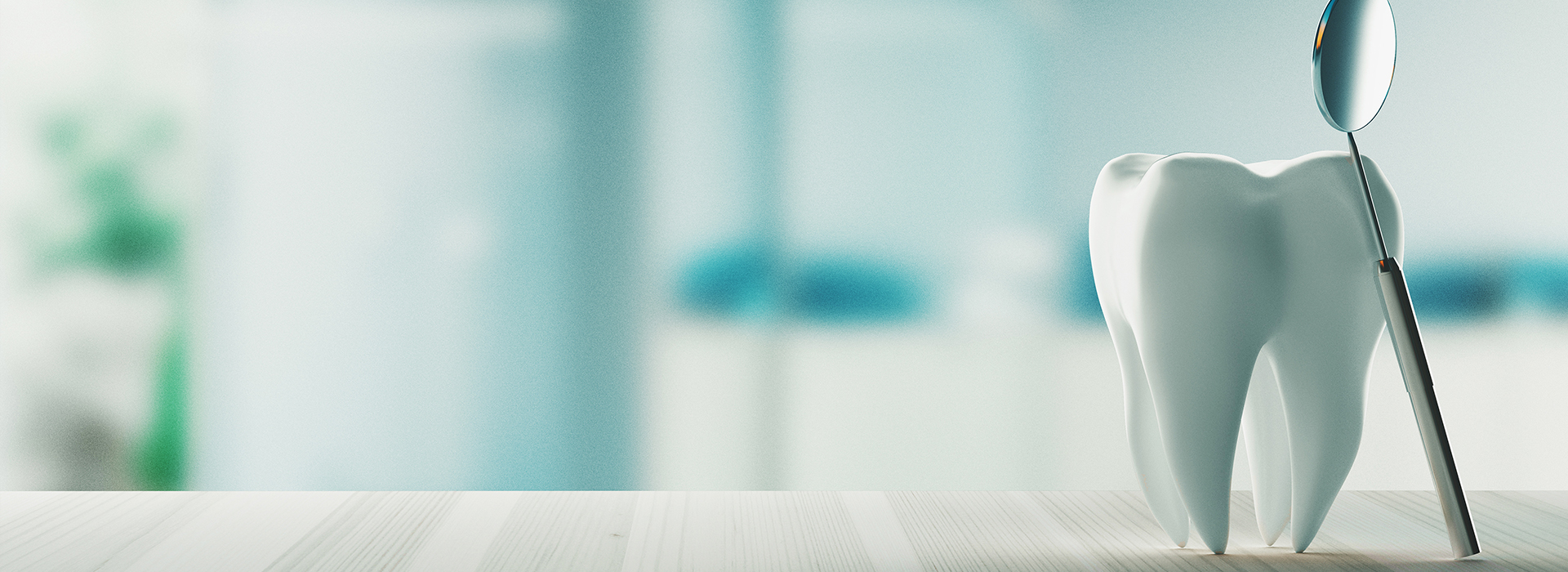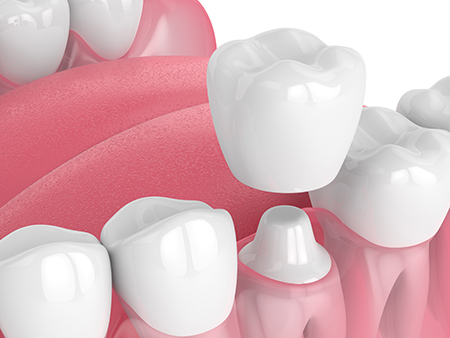We speak English, Spanish and Portuguese
We speak English, Spanish and Portuguese

At Inspirational Smiles, our goal is to restore both the look and the function of teeth using modern materials and techniques. We combine careful diagnosis with thoughtful treatment planning so each crown supports long-term oral health while blending naturally with your smile. Our approach emphasizes durability, biocompatibility, and an outcome that feels comfortable and confident.
Tooth enamel is incredibly strong, yet teeth can still succumb to decay, fracture, or the cumulative wear of everyday use. Simple fillings are an effective fix for many situations, but when a tooth has lost substantial structure—because of decay, a large previous restoration, root canal therapy, or chronic grinding—a full-coverage crown is often the more predictable solution.
Advances in ceramic materials mean crowns today can be fabricated without metal frameworks while offering excellent strength and aesthetics. All-ceramic crowns replicate the translucency, color, and surface texture of natural teeth, giving restorative results that are both functional and highly pleasing to the eye.
Throughout treatment, our team focuses on patient comfort and clear communication. We tailor each plan to a person’s oral health needs and cosmetic goals so the finished restoration fits seamlessly with the rest of the mouth and supports long-term success.
Deciding whether a crown is the right procedure involves considering how much tooth structure remains and what the tooth must endure in daily function. Crowns fully cover the visible portion of a prepared tooth, restoring shape and strength and protecting the remaining natural tooth from further damage.
Many situations call for a crown rather than a filling, including teeth with large defects that compromise structural integrity, teeth that have been endodontically treated, or teeth that anchor a dental bridge or implant restoration. The intent is to prevent future fracture and to reestablish a reliable chewing surface.
We also recommend crowns for teeth with significant cosmetic concerns—such as deep staining or misshapen anatomy—when conservative veneer options are insufficient. In all cases, the decision balances function, longevity, and how the finished restoration will harmonize with surrounding teeth.
To rebuild a tooth that has extensive decay or has broken
To replace or protect a large, failing filling
To restore a dental implant or serve as a bridge abutment
To shield a tooth after root canal therapy or when clenching and grinding have weakened it

All-ceramic crowns are engineered to closely mimic the optical properties of natural enamel. Unlike older restorations that used visible metal substructures, modern ceramic materials interact with light in ways that produce lifelike translucency, depth, and surface sheen. The result is a restoration that is difficult to distinguish from a healthy natural tooth.
Today’s ceramics also deliver improved mechanical performance. Engineered glass-ceramics and high-strength zirconias can withstand normal chewing forces while resisting chipping and wear. This blend of physical durability and refined appearance makes ceramic crowns suitable for both front and back teeth, depending on the chosen material and case requirements.
Another important benefit of metal-free crowns is biocompatibility. For patients with sensitivities or who prefer to avoid metal in dental restorations, ceramic crowns offer a safe alternative that is also resistant to staining and corrosion, contributing to long-term color stability and soft tissue health.
Natural-looking translucency and color matching
Reduced need for aggressive tooth reduction with some ceramic systems
Lightweight restorations without a metal margin at the gumline
Improved soft-tissue response and resistance to discoloration

Not all ceramic materials are the same, and choosing the right one depends on where the crown will sit, how much force it must resist, and the aesthetic expectations for the tooth. Our clinicians evaluate occlusion, bite dynamics, and the shade and translucency of neighboring teeth before recommending a material.
For a back tooth subjected to heavy chewing loads, a more robust ceramic such as monolithic zirconia may be preferred for its high fracture resistance. For front teeth where appearance is paramount, layered or high-translucency lithium disilicate systems can achieve exceptional esthetics while still providing dependable strength.
Our team explains the pros and cons of each option, including how they influence preparation design, longevity, and final appearance. This helps you make an informed decision that aligns with both functional needs and cosmetic goals.
Lithium Disilicate (esthetic and versatile for many situations)
Leucite-reinforced pressable ceramics (excellent color and polishability)
Solid or monolithic zirconia (exceptionally strong for posterior teeth)
High-translucent zirconia (a balance between strength and improved esthetics)

The crown process typically begins with a thorough assessment, digital imaging, and, when appropriate, minimally invasive tooth preparation. Our priority is to preserve as much healthy tooth structure as possible while creating a stable foundation for the restoration.
Impressions or digital scans are used to precisely capture the prepared tooth and surrounding dentition. These details guide the laboratory or in-office milling system in fabricating a crown that fits accurately, respects your bite, and matches adjacent teeth for a seamless appearance.
Temporary protection is provided while the final crown is being completed. At the seating appointment, adjustments ensure proper contacts and comfortable occlusion before the restoration is permanently bonded or cemented. We review home care and maintenance tips so your new crown performs well for years to come.
Our practice brings together clinical experience, modern materials, and a patient-centered workflow to deliver restorations that last and look natural. We emphasize careful planning and ongoing communication so every crown contributes to a healthier, more resilient smile.
From material selection to final polishing, attention to detail is central to our approach. We combine conservative tooth preparation with precise laboratory or digital milling techniques to create crowns that meet both functional demands and cosmetic expectations.
If you’re considering a crown, our team will explain the treatment steps, review the available ceramic options, and recommend the solution that best supports your oral health and appearance. Our commitment is to predictable, high-quality outcomes that help you smile with confidence.
To learn more about ceramic crowns and whether they are right for you, please contact us for additional information.

While a dental filling is designed to replace a portion of a decayed or damaged tooth, a dental crown offers full coverage to restore the tooth’s entire outer surface. A well-fitting dental crown not only protects and strengthens the underlying tooth structure, but it also restores the tooth’s appearance and function.
The procedure for getting an all-ceramic crown is much like the procedure for getting any other type of crown. In all cases, the tooth needs to be prepared, an impression taken, and a permanent crown cemented into place. A single all-ceramic crown can typically be fabricated over the course of two visits. However, with CAD/CAM technology, a same-day crown can be fabricated from start to finish in a single visit. With the first approach, a temporary crown is typically worn until the second visit, when the permanent restoration is placed. As with every treatment plan, our office will explain your best options in care.
As the name implies, a temporary crown is only worn for a short time until the permanent crown is placed. A temporary crown is typically fabricated from durable tooth-colored dental acrylics. While designed to protect the underlying tooth between appointments, and until your new permanent crown gets placed, a temporary crown is also fabricated to look like a natural tooth and maintain the look of your smile.
While you should feel better having an attractive and functional tooth to restore your smile, your tooth may feel a little sensitive following treatment. This initial sensitivity will subside. We take great care to make sure your new restoration looks great, fits well, and your bite is perfect. However, we’re always happy to make any minor adjustments to ensure your comfort.
With some exceptions, teeth with root canal procedures are typically restored and protected from further damage with a full-coverage crown. Based on what’s best for your smile, our office will recommend the most appropriate restoration to maintain the health and longevity of your tooth following a root canal procedure.
A dental crown is a long-term restoration that, if properly cared for, can serve you well for many years to come. Once your new crown is placed, it requires the same brushing, flossing, and periodic checkups as your natural teeth. Avoid biting your fingernails and chewing on hard or sticky objects such as ice, pencils, or taffy, which can damage or loosen your crown. Remember, clenching and grinding your teeth puts excessive pressure on both natural teeth and dental restorations. Unless treated, this habit can compromise the longevity and integrity of your dental work, including crowns.
Although your new all-ceramic crown restores the tooth's strength, form, and function, you can still develop dental disease in the absence of proper care. To prevent gum disease and tooth decay, it’s essential to brush and floss as instructed and see our office for routine checkups, cleanings, and care.
How long a dental crown lasts depends on various factors, including your level of oral care, diet, and oral habits. While the standard answer is that dental crowns can last anywhere from 5 to 15 years, existing literature confirms that most dental crowns remain in place at 15 to 20 years.
At the office of Inspirational Smiles, we strive to provide the highest quality of care to address all your dental needs. Once we’ve had the opportunity to examine your smile, we can give you a clear picture of any dental issues that are present, along with a quote for how much treatment will be. The cost of dental crowns can vary a little, depending on the type of crown and its location. Our goals are to provide the highest quality of care and help patients begin treatment without additional financial stress or delay. We’re always happy to answer all your questions on dental insurance coverage, available financing, and payment plans.
Coverage for all-ceramic crowns depends on your dental insurance plan. Today, many dental plans provide some level of coverage for all-ceramic crowns. At the office of Inspirational Smiles, we work with patients to optimize their dental benefits and get the care they need to maintain healthy and beautiful smiles!
Ceramic crowns are metal-free restorations made from dental porcelains or engineered ceramics that replicate the color, translucency, and surface texture of natural teeth. They are designed to fully cover a prepared tooth to restore shape, strength, and function while providing highly aesthetic results. Unlike traditional crowns with metal substructures, ceramic crowns interact with light similarly to enamel, making them difficult to distinguish from surrounding teeth.
The choice of ceramic material influences both appearance and performance, so clinicians select systems that balance optical properties with mechanical strength. Ceramic restorations also offer improved biocompatibility for many patients and reduced risk of a visible dark margin at the gumline. When planned and placed correctly, these crowns provide a durable and visually pleasing option for restoring compromised teeth at Inspirational Smiles.
A ceramic crown is typically recommended when a tooth has lost substantial structure due to decay, fracture, a large existing restoration, or after root canal therapy. Crowns fully encapsulate the remaining tooth to protect it from further damage, restore proper chewing surfaces, and reestablish form and function. They are also used to anchor bridges and to cap dental implants when a fixed, stable restoration is required.
In addition to functional needs, crowns are chosen for aesthetic concerns when discoloration or misshapen anatomy cannot be resolved with more conservative treatments like veneers. The decision is individualized and considers the location of the tooth, occlusal forces, and long-term prognosis. Your clinician will weigh these factors to recommend whether a crown is the most predictable solution for your situation.
Several ceramic systems are used for crowns, each with different strengths and optical characteristics. Common options include lithium disilicate for its balance of esthetics and strength, leucite-reinforced pressable ceramics for excellent color and polishability, high-translucency zirconia for a mix of durability and appearance, and monolithic zirconia when maximum fracture resistance is needed.
Each material has advantages and trade-offs related to translucency, need for tooth reduction, and resistance to chipping or wear. The clinical team evaluates the functional demands and aesthetic goals of the case to recommend the material that best meets those requirements. This selection process helps ensure the restoration performs well and blends with surrounding dentition.
The process normally begins with a comprehensive evaluation, digital imaging or X-rays, and discussion of material options and treatment goals. Tooth preparation is performed to create a stable foundation while preserving as much healthy structure as possible, followed by impressions or a digital scan to capture precise details of the prepared tooth and surrounding bite.
While a laboratory or in-office milling system fabricates the final crown, a temporary restoration protects the prepared tooth. At the seating visit the dentist checks fit, contacts, and occlusion before bonding or cementing the crown, then provides instructions for care and schedules follow-up to confirm comfort and function.
Ceramic crowns can be suitable for both anterior and posterior teeth, but the specific material choice depends on location and bite forces. Highly translucent ceramics such as lithium disilicate are often preferred for front teeth where appearance is paramount, while stronger options like monolithic zirconia are commonly selected for molars that endure heavier chewing loads.
The dentist evaluates occlusal dynamics, aesthetic priorities, and any parafunctional habits such as grinding when recommending a material. In many cases a compromise material such as high-translucency zirconia can provide a good balance between strength and natural appearance for teeth in transitional positions.
Caring for a ceramic crown follows the same principles as caring for natural teeth: brush twice daily with a fluoride toothpaste and floss once a day to remove plaque around the crown margins. Avoid using highly abrasive toothpastes and limit habits that place unusual stress on the restoration, such as biting hard objects or chewing ice. Maintaining good periodontal health around the crown is essential to prevent recurrent decay at the crown-tooth interface.
Regular professional cleanings and routine exams allow the dental team to monitor the crown and detect early signs of wear, leakage, or chipping. If you have a history of grinding or clenching, ask your dentist about a nightguard to protect both natural teeth and restorations. Prompt attention to any unusual sensitivity, looseness, or roughness helps preserve the restoration and overall oral health.
After crown placement it is common to experience mild sensitivity to temperature or pressure for a short period as the surrounding tissues adjust. The bite may feel slightly different at first, and a brief adjustment appointment is sometimes needed to refine occlusion and ensure even contacts. Over-the-counter analgesics and soft foods can help manage temporary discomfort while healing occurs.
If you notice persistent sensitivity, a loosened crown, or a sharp edge, contact the dental office so the team can assess and make any necessary corrections. Maintaining careful oral hygiene and avoiding sticky or excessively hard foods during the initial settling period will help protect the new restoration. Routine follow-up appointments allow the dentist to confirm that the crown is functioning as intended and that surrounding tissues remain healthy.
Ceramic crowns are designed to be long-lasting, and many remain functional for many years with appropriate care. Longevity depends on several factors including the chosen material, quality of the fit and bonding, oral hygiene, bite forces, and any habits such as grinding or biting hard objects. The condition of the supporting tooth and the presence of decay or periodontal disease at the time of treatment also influence long-term success.
Regular dental examinations and preventive care help identify issues early so restorations can be maintained or repaired before failure occurs. If a crown shows signs of chipping, recurrent decay, or marginal breakdown, the dentist can recommend repair or replacement options to restore function and protect the underlying tooth. Careful planning and material selection by the clinician play a major role in maximizing the restoration's service life.
Yes, ceramic crowns are an excellent choice for patients who prefer to avoid metal or have metal sensitivities, because they are metal-free and highly biocompatible. Ceramics do not corrode and are resistant to discoloration, which helps maintain stable color and a healthy soft-tissue response around the restoration. For patients with known allergies or concerns about metals, ceramic systems provide a predictable alternative that reduces the risk of adverse reactions.
The dental team will review your medical and dental history to confirm that a ceramic restoration is appropriate and to select the best material for both health and aesthetic goals. If special considerations are needed, the practice can coordinate options that meet clinical requirements while addressing patient preferences. Clear communication about sensitivities and expectations helps ensure a successful outcome.
Selecting the right ceramic involves an evaluation of functional needs, aesthetic goals, and the clinical condition of the tooth. The dentist assesses the bite, opposing dentition, shade and translucency of neighboring teeth, and any parafunctional habits before recommending materials that balance strength and appearance. In some cases the team will use digital simulations, shade-matching tools, or diagnostic wax-ups to preview the result and guide material choice.
Communication with the patient about expected outcomes and maintenance helps align treatment decisions with individual priorities. Skilled laboratory or in-office milling techniques and meticulous finishing work are then used to achieve a precise fit and natural appearance. This collaborative approach ensures the selected crown supports long-term oral health while delivering an aesthetic result you can feel confident about.

Looking to schedule your next dental visit or learn more about our services?
Getting in touch with Inspirational Smiles is simple! Our caring team is ready to help with appointment scheduling, questions about treatments, or any concerns you may have. You can call us or use our easy online contact form—whatever works best for you.
Take the first step toward a healthier, more confident smile today and experience the difference that personalized, compassionate dental care can make.